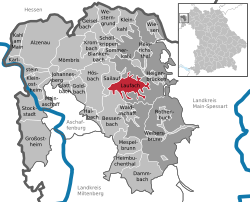Laufach
| Laufach | ||
|---|---|---|
|
||
| Coordinates: 50°01′N 09°18′E / 50.017°N 9.300°ECoordinates: 50°01′N 09°18′E / 50.017°N 9.300°E | ||
| Country | Germany | |
| State | Bavaria | |
| Admin. region | Unterfranken | |
| District | Aschaffenburg | |
| Government | ||
| • Mayor | Friedrich Fleckenstein | |
| Area | ||
| • Total | 15.60 km2 (6.02 sq mi) | |
| Elevation | 180 m (590 ft) | |
| Population (2015-12-31) | ||
| • Total | 5,297 | |
| • Density | 340/km2 (880/sq mi) | |
| Time zone | CET/CEST (UTC+1/+2) | |
| Postal codes | 63846 | |
| Dialling codes | 06093 | |
| Vehicle registration | AB | |
| Website | www.laufach.de | |
Laufach is a community in the Aschaffenburg district in the Regierungsbezirk of Lower Franconia (Unterfranken) in Bavaria, Germany.
The community lies in northwest Bavaria east of Aschaffenburg. Laufach lies in the heart of the Vorspessart (range) and stretches through its outlying centre of Hain into the High Spessart. The community’s elevation ranges from 170 to 500 m above sea level.
Laufach’s Ortsteile are Frohnhofen (898 inhabitants), Hain (1,177 inhabitants) and Laufach (3,204 inhabitants).
In 1084, Laufach, which was originally known as Laufahe, had its first documentary mention in an obituary from Saints Peter’s and Alexander’s Monastery in Aschaffenburg. Laufach’s name came from the stream on which it was built. Over the years, the community’s name has changed many times, from Laufache in 1182, to Loifahe in 1191, to Loupha in 1348, to Lauffach around 1528 and 1624 before settling on Laufach in the early 19th century.
The Laufach valley was settled under the protection of the Counts of Rieneck, who already held the Vogtei (position of Vogt) from the Archbishopric of Mainz and the collegiate church in Aschaffenburg. On the Rieneck free court in 1380 – where Schöffen (roughly “lay jurists”) from Laufach were specifically mentioned – sat settlers as free citizens.
In the mid 14th century, glassmakers were brought into service in the High Spessart with special incentives. Since they had to leave the forest from Martinmas (11 November) until Easter, they sought winter dwellings in Hain and Laufach. Many of these workers settled down here owing to family ties. Already by 1469, there was a mine near the “Weyber” Palace (Schloss „Weyber“, Weyberhöfe). In “Unserer lieber Frauen Teil”, presumably part of the “Liebesgrund” (“Love Ground”), copper was mined. After the Thirty Years' War, ores were mined and smelted.
...
Wikipedia



